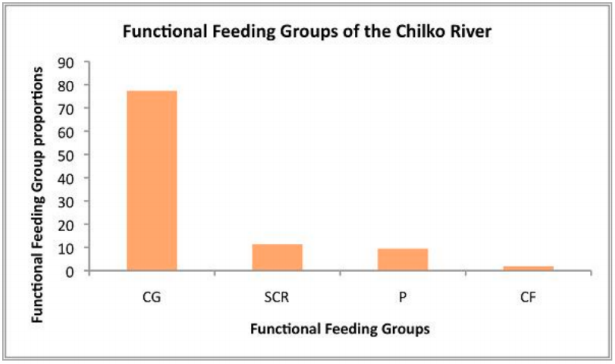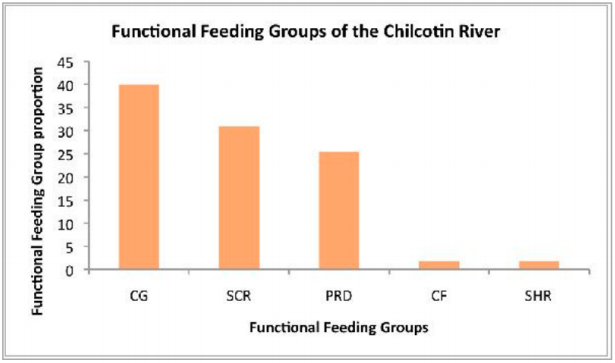The Chilcotin and Chilko Rivers differ considerably before they unite to form the Chilko-Chilcotin River. The Chilko is much larger, with a high amount of suspended glacial flour acquired from the Taseko River. The Chilcotin River on the other hand drains agricultural lands, is tea colored, and shallow by comparison. The different characteristics of the rivers affect macroinvertebrate diversity, water quality metrics and functional feeding group (FFG) proportions.
With few scrapers, predators, or collector filterers, the Chilko River was dominated by collector gathering invertebrates (77.35%). The Chilcotin River was also dominated by collector gatherers, but had a high abundance of scrapers and predators. Shredders were also found in the Chilcotin River.
The Chilko River and the Chilcotin River both had similar EPT values indicating that they both had comparable habitat suitability for gill breathing invertebrates. However, the two rivers differed dramatically in terms of diversity. The Chilko River had a taxa richness of 8 families, while the Chilcotin had nearly twice the number of families (Table 1). The Simpsons Index of Diversity was extremely different between the two streams (Table 1). The Chilko River diversity value was 0.445 while the Chilcotin had a value nearly double that amount.
The differences in diversity and functional feeding group proportions may be due differences in size and land use between the two rivers. By the river continuum concept large volume rivers are dominated by collector gatherers, while streams with lower volume and considerable width have a large proportion of scrapers. Similarly the stark difference in diversity could be a function of river size, however, agricultural use may also influence diversity in the Chilcotin River. The Chilcotin River drains agricultural lands that may add nutrients to the river. An increase in nutrients would allow for a larger resource base for aquatic invertebrates. With a larger pool of available resources, there may be less competition. This would help accommodate for a greater amount of taxa within the stream, especially scrapers, by enhancing periphyton growth. Nutrients from agricultural lands may help bolster the Chilcotin River's invertebrate diversity.



